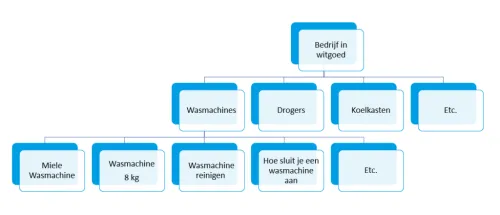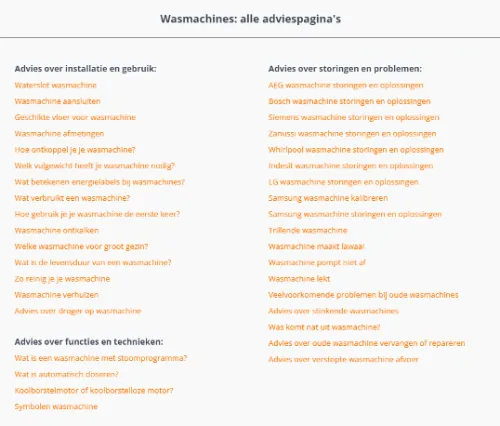In the world of SEO (Search Engine Optimization), topic clusters form a crucial strategy for those looking to increase their online visibility. By using topic clusters, we demonstrate to Google and other search engines that we are true experts in specific areas. A topic cluster consists of a central main\/pillar page that covers general, highly searched keywords, surrounded by related subpages\/cluster pages that delve deeper into specific questions and topics. This approach not only boosts website traffic but also increases the value of the main page.
Example of a Topic Cluster
Let's clarify the essence of topic clusters with a practical example. Keep in mind a company in white goods that offers washing machines. “Washing Machine” is a commonly used keyword with a monthly search volume of 76,000. Given the fierce competition, simply optimizing your website for this popular keyword is often not enough to rank high in search results.
The purchase and installation of washing machines involve many specific questions. This is where topic clusters prove their value. By grouping related subtopics and questions into subclusters, you can create a network of targeted content.
Consider search queries like:
- Miele washing machine
- Washing machine 8kg
- Cleaning a washing machine
- How to connect a washing machine

Take, for example, a store like Expert. They use topic clusters by addressing frequently asked questions and subtopics that are less competitive than the broad keyword “washing machine”. This results in an increase in website traffic over a wide range of related keywords, indirectly boosting the visibility and traffic to the main page about washing machines. These strategic subclusters refer back to the main page, showing search engines that they possess in-depth knowledge about washing machines – a testament to their authority in this niche.

Why Topic Clusters Are Essential for Your SEO Strategy
Google’s algorithms are constantly evolving and increasingly emphasize the expertise and authority of content (EEAT). By effectively using topic clusters, a website can build its authority in a particular area, especially for sites still working to increase their domain authority.
This is a long-term strategy that requires patience, but building a solid foundation with topic clusters can lead to significant improvements in search results in both the short and long term.
The Three Pillars of Topic Clusters
An effective implementation of topic clusters rests on three fundamental pillars: the main page, the cluster pages, and the internal links that connect these pages and content.
Main Page
The main page serves as the central information point for a broad topic (washing machines). This page focuses on general keywords with high search volume and lays the foundation for an in-depth exploration through the cluster pages.
Characteristics of a Strong Main Page:
- Comprehensive coverage of the topic with a focus on broad, commonly used keywords.
- Clear structure that easily guides readers to specific information.
- Clear references to related subtopics on the cluster pages, with inviting calls-to-action.
Cluster Pages
The cluster pages delve deeper into specific aspects or questions related to the main page's topic (Miele washing machine or cleaning a washing machine). They aim to provide detailed answers and insights into specific questions, targeting long-tail keywords that are less competitive but highly relevant.
Characteristics of a Cluster Page:
- Specifically targeted content on sub-questions or subtopics.
- Optimized for long-tail keywords, improving findability for targeted searches.
- Valuable information that genuinely helps the reader.
Internal Links
Internal links connect the main page with cluster pages and vice versa, creating a network of relevant content. These links are essential for indicating content relationships to search engines and distributing link value across the site. They not only facilitate navigation for the user but also strengthen the coherence and understanding of the site as a whole.
Characteristics of Strategic Internal Links:
- Placement of links where they are relevant and helpful to the reader.
- Descriptive anchor texts that clearly indicate what visitors can expect on the linked page.
- A balanced distribution of links, ensuring each cluster page is connected to the main page and, if relevant, to other cluster pages.
By focusing on a strong main page, detailed cluster pages, and thoughtful internal links, you create a structure that not only helps search engines index and value your site but also offers a richer experience to visitors. This foundation is essential for long-term SEO success and helps build authority and trust in your field.
Getting Started with Topic Clusters in 4 Steps
- Determine the Main Topic
- Conduct Keyword Research
- Identify Subtopics
- Create a Content Plan
Step 1: Determine the Main Topic
When choosing a main topic, it's important to select a theme that offers a wide range of subtopics while being relevant to your brand, product, or service. The topic should be central to your company's expertise and fulfill the information needs of your visitors.
Step 2: Conduct Keyword Research
Using SEO tools and your own data, you can start gathering data on keywords relevant to your main topic. Focus not only on keywords with high search volume but also delve into long-tail keywords that often reflect users' specific questions. For our “washing machine” example, this research might reveal that many users search for “energy-efficient washing machines” or “washing machine makes noise”.
Step 3: Identify Subtopics
After gathering a list of keywords, the next step is to segment them into logical groups that form subtopics. Each subtopic should have enough informational potential to create a rich, content-rich page. Always be mindful of keyword cannibalization (more on that later). Perhaps multiple questions can be answered on one page, or perhaps not.
Step 4: Create a Content Plan
Develop a content plan that encompasses the main page and each subtopic. Determine the purpose and unique value of each page. Plan the creation of content that is informative, engaging, and valuable to your visitors.
How will each subpage link to the main page and to each other? This must be strategically planned to maximize SEO value and guide users through your website.
Beware of Keyword Cannibalization!
When clustering topics and writing content, it's important to combine relevant keywords. If you don't and cover the same topics on different cluster pages, Google won't know which content is more important.
It can also happen that the main page is found for keywords for which you have created a cluster page. In that case, it may be that, for example, the pillar page is better optimized for the keyword than the cluster page. This can also happen the other way around. So check carefully which keywords you will apply where and avoid cannibalization. You can do this, for example, by keeping a clear content roadmap that maps out which pages exist and which keywords rank per page.
Summary
- Topic Clusters Increase SEO Value: Using topic clusters improves the visibility and authority of your website by grouping related content around a central main page, helping search engines understand that you are an authority in that area.
- Main and Cluster Pages: By combining a main page (pillar page) with in-depth cluster pages (subpages) that address specific questions, you not only target general keywords but also specific long-tail keywords.
- A Proper Internal Link Structure is Crucial: Strategic internal links between the main page and cluster pages distribute SEO value and help users and search engines navigate and understand your website's structure.
- Keyword Research and Subtopic Identification: Thorough keyword research is essential for identifying relevant subtopics that each can form a cluster page, addressing the specific needs and questions of your audience.
- Avoid Keyword Cannibalization: Be careful when assigning keywords to pages to prevent different pages from competing for the same keywords.
Curious about how you can best use topic clusters? Feel free to contact us and we will gladly help you with good SEO advice!




